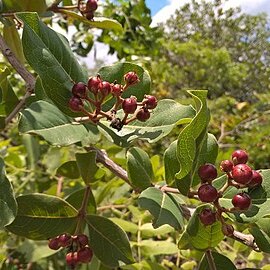Leaves coriaceous, deciduous, usually strictly opposite, subsessile or shortly petiolate; lamina up to 11 × 8 cm. but often much smaller, varying from subrotund to ovate, obovate, or elliptic, acute, obtuse or rounded at the apex, subcordate to rounded or broadly cuneate at the base, glabrous or glabrescent above, varying from glabrous to densely rusty-tomentose below but always white or pallid with conspicuous reticulate venation, the tertiary veins often prominent, with dark glandular dots usually ± confined to the apex and margins; petiole up to 2 (4) mm. long, glabrous or rusty.
A shrub or small tree. It grows 4 m high. It has many branches. The bark is often corky and peels off. The stems can be round and smooth or angular and hairy. The leaves are leathery. The fall off during the year. The leaf blade is 11 cm long by 8 cm wide but is often much smaller. They have a rusty coating underneath. The flowering shoots are on the ends of branches. The petals are white with dark red streaks. The fruit is a bright red berry. It is 10 mm across. The seeds are 5 mm long. The plant is very variable.
Inflorescence terminating main or lateral shoots, cymose, appearing paniculate, variable in size and in degree of indumentum, usually pedunculate, branches ± quadrangular.
Petals up to 6 mm. long, elliptic to obovate, acute, white or yellowish-white, streaked with dark purple-red.
Shrublet to shrub or small tree (0·3) 1–6 m. high, much branched, with bark peeling or flaking, often corky.
Stems terete (sometimes flattened or ± quadrangular above), glabrous to densely rusty-tomentose.
Sepals 3–4 mm. long, elliptic to lanceolate, rusty-tomentose or glabrescent outside.
Fasciclodes glabrous, bfid to truncate or apiculate.
Stamens 5–6 per fascicle; filaments villous.
Berry bright red, c. 10 mm. in diam.
Seeds c. 5 mm. long.


